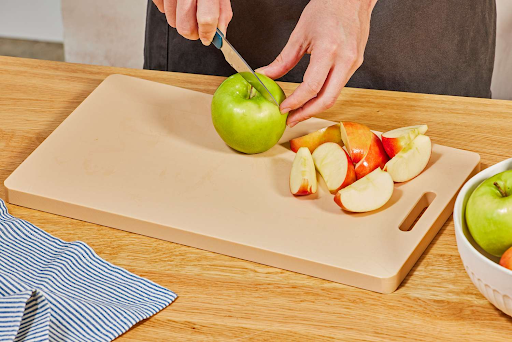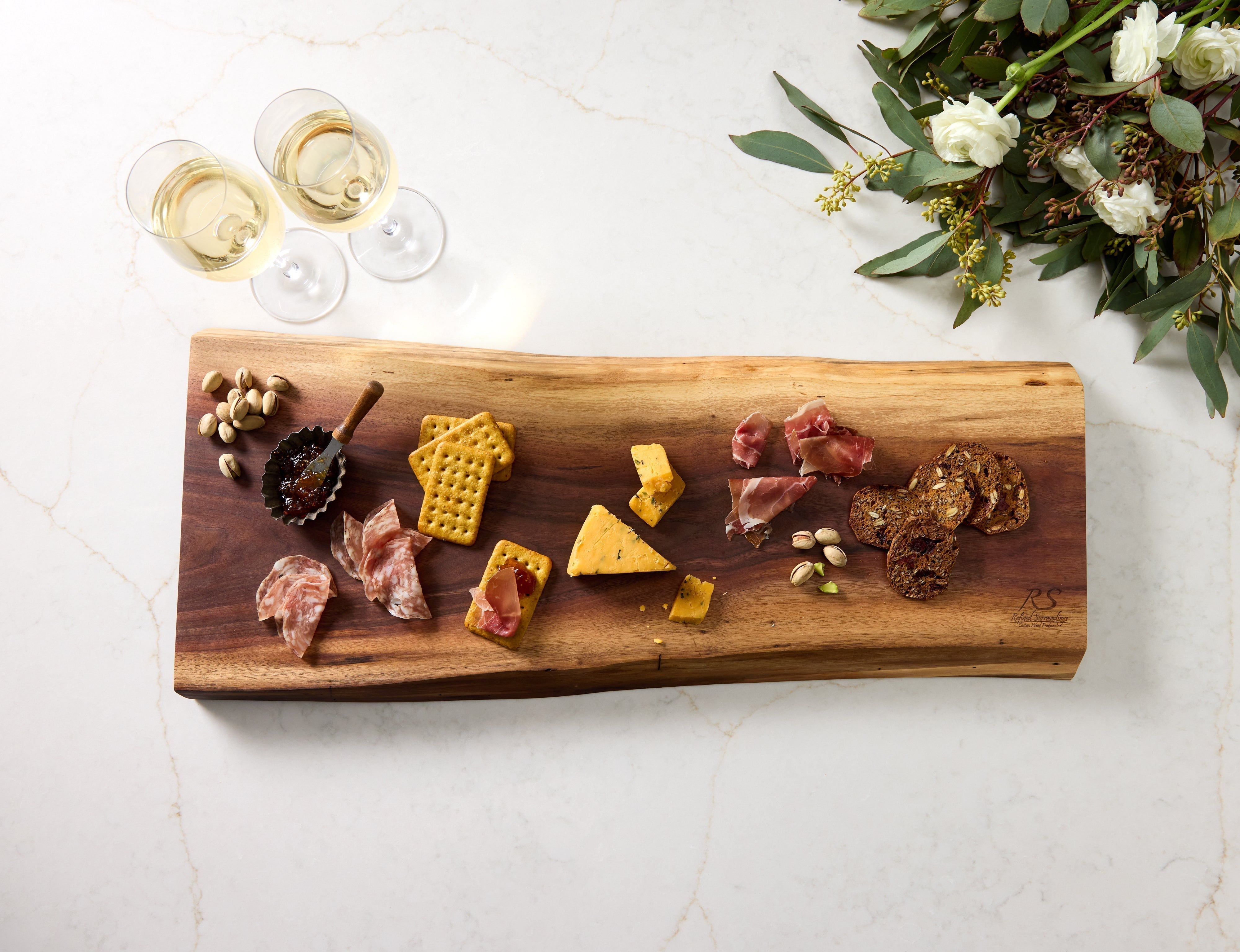
Are Plastic Cutting Boards Safe? The Hidden Risks of Microplastics in Your Kitchen
Key Takeaways
Plastic cutting boards can release microplastics and harbor bacteria, raising serious health concerns over time.
- The safest cutting board material is wood, particularly walnut, maple, and cherry, due to their natural antimicrobial and non-toxic properties.
- The best non toxic cutting boards are made from solid hardwoods and finished with food-grade oils.
- Replacing your board with a high-quality, handcrafted wood option is a small but powerful upgrade for a healthier, more sustainable kitchen.
Introduction
Are plastic cutting boards safe? It’s a question more home cooks are asking as awareness grows around microplastics, food safety, and sustainable living. For years, plastic cutting boards have been praised for their affordability and convenience but new research is causing many to reevaluate their place in the kitchen.
From hidden toxins to environmental impact, plastic boards are no longer the clear winner they once seemed to be. In this article, we explore the hidden risks of plastic, how it compares to other materials, and why switching to a non-toxic wooden cutting board is one of the easiest ways to make your kitchen cleaner, healthier, and more beautiful.
Why Plastic Cutting Boards Became Popular
Plastic boards earned their spot in many kitchens by solving some very real problems:
- They’re inexpensive and widely available
- They’re lightweight and easy to move around
- They can be color-coded for different food groups
-
They’re dishwasher safe, which gives the illusion of deep cleaning
For fast-paced kitchens, especially in restaurants, plastic seemed like a low-maintenance solution. But as home cooks and food safety experts have dug deeper, those advantages have started to unravel.
What was once seen as a practical choice is now being questioned for its long-term health implications and its role in environmental degradation.
The Hidden Risks of Plastic Boards

Let’s revisit the question: Are plastic cutting boards safe? At a surface level, they’re easy to clean and affordable. But just beneath that convenience are several concerns:
Microplastic Shedding
One of the biggest issues with plastic boards is microplastic release. Each time you slice, chop, or dice, your knife scratches the surface. Over time, these tiny grooves weaken the plastic, causing small particles to flake off, sometimes invisible to the eye.
These microplastics can cling to food, particularly moist or fatty items, and enter your digestive system without you knowing. Studies suggest they may accumulate in the body and contribute to inflammation, hormone disruption, and even toxicity over time.
Bacterial Buildup
Plastic boards may appear smooth when new, but as they wear down, they form deep crevices. These cuts trap bacteria that can survive standard washing, yes, even in the dishwasher.
Unlike wood, which naturally inhibits bacterial growth, plastic does little to prevent microbes from lingering and multiplying in grooves.
Durability and Environmental Waste
Because they wear down quickly and become harder to sanitize over time, plastic cutting boards need to be replaced often—sometimes every few months in busy kitchens. Most of these discarded boards aren’t recyclable, contributing to long-term plastic waste in landfills and oceans.
So, while plastic boards may seem safe or practical in the short term, they’re far from the healthiest or most sustainable choice.
How Plastic Compares to the Safest Cutting Board Materials
Hardwood is considered to be the safest and healthiest cutting board. Here’s how the most common materials stack up when it comes to safety, hygiene, and longevity:
|
Material |
Safety |
Knife-Friendly |
Hygiene |
Sustainability |
Overall Verdict |
|
Wood (walnut, maple, cherry) |
Excellent |
Excellent |
Very Good |
Excellent |
Best overall |
|
Plastic |
Low |
Moderate |
Poor |
Very Poor |
Risky choice |
|
Bamboo |
Moderate |
Poor (too hard) |
Good |
Good |
Acceptable backup |
|
Glass |
Very Poor |
Extremely Poor |
Good |
Moderate |
Avoid completely |
Wooden cutting boards, especially those made from high-quality hardwoods, clearly come out on top for health, safety, and environmental performance.
Learn More on why you should switch from plastic to wood and why hardwood cutting boards are the healthiest.
Why Wood Is the Best Non-Toxic Cutting Board Choice
If you’re looking for the best non toxic cutting board, you want one that’s not just free of harmful chemicals but one that naturally helps protect your food and tools.
Food-Safe Finishes
The best wood boards are finished with natural mineral oil or beeswax, no synthetic varnishes, lacquers, or chemical sealants. This keeps them safe for raw and cooked foods alike.
Naturally Antimicrobial
Hardwoods like walnut and maple have natural antimicrobial properties that suppress bacterial growth, especially when compared to plastic. Their dense grain also minimizes moisture absorption, which further reduces the risk of bacteria.
Long-Term Durability
Unlike plastic, a well-maintained wooden board can last 10 years or more, developing a beautiful patina over time and serving multiple functions: food prep, cheese display, countertop decor, and more.
When it comes to safety, sustainability, and aesthetics, hardwood boards check every box.
Also Read: How to Clean and Maintain Wooden Cutting Boards (Without Damaging Them)

What Makes a Cutting Board Truly Healthy
The healthiest cutting boards all share a few important characteristics:
- Non-toxic finishes and materials: No varnishes, BPA, or synthetic glues
- Durable construction: Withstands knife marks without splintering or breaking down
- Antimicrobial properties: Naturally resists bacterial contamination
- Knife-safe surface: Doesn’t dull your blades over time
- Easy to clean and maintain: Requires only water, soap, and occasional oiling
-
Sustainably sourced: Harvested from renewable, eco-conscious materials
This combination ensures that your board supports your health instead of compromising it. A good cutting board is as much about what it doesn’t contain as what it’s made from.
What to Look For When Replacing Your Cutting Board
If you’re ready to switch from plastic to something safer, here’s a quick checklist to help guide your purchase:
1. Material
Stick to solid hardwoods, walnut, maple, or cherry are ideal. Avoid glued-together boards, particle wood, or laminated surfaces that might contain adhesives.
2. Finish
Ensure the board is treated with food-grade mineral oil or beeswax, not varnish, shellac, or resin-based finishes.

3. Construction
Choose a board with adequate thickness (at least ¾") and weight. Thicker boards resist warping and last longer.
4. Maintenance
Look for boards that come with care instructions. The best ones are easy to oil, don’t require sanding, and are designed for regular use.
5. Design & Aesthetics
Bonus points for boards that are beautiful enough to double as a serving or charcuterie tray. You want something you’ll enjoy keeping on your countertop.
Refined Surroundings offers handcrafted cutting boards made from American hardwoods, finished with food-safe oil, and designed for everyday use. They’re a smart and beautiful upgrade from plastic.
Explore Handcrafted Cutting Boards Designed for a Healthier Kitchen
Whether you’re prepping dinner, arranging charcuterie, or gifting a friend, a non-toxic hardwood cutting board is a smart, stylish, and sustainable investment.
Shop our collection of walnut, maple, and cherry cutting boards. Made to last. Made to love. Made with your health in mind.
Final Thoughts
So, are plastic cutting boards safe?
In truth, they’re convenient but compromised. They may be fine for occasional use, but with daily wear, they become breeding grounds for bacteria and potential sources of microplastic exposure. The risks both to your health and the environment simply aren’t worth it.
If you care about what goes into your body, how your tools perform, and what kind of kitchen you want to live in, the solution is clear. The safest, healthiest cutting board is one made from solid hardwood, crafted with care, and maintained with intention.
Switching from plastic to wood is one of the simplest yet most powerful ways to reduce waste, avoid toxins, and create a cleaner, safer kitchen.
Frequently Asked Questions
Q: Are plastic cutting boards safe for long-term use?
A: Plastic cutting boards may seem safe at first, but over time they develop grooves that trap bacteria and release microplastics. This makes them a less healthy and less sustainable choice compared to wood.
Q: What is the safest cutting board material?
A: The safest cutting board material is solid hardwood—especially walnut, maple, and cherry. These woods are naturally antimicrobial, non-toxic, and more durable than plastic or bamboo.
Q: How do I know if a cutting board is non-toxic?
A: The best non toxic cutting board is made from solid wood and finished with food-grade mineral oil or beeswax. Avoid boards with varnishes, resins, or plastic coatings.
Q: Can plastic cutting boards go in the dishwasher?
A: Yes, but that doesn’t make them safer. Dishwasher heat can degrade the surface, making it more prone to shedding microplastics and harboring bacteria.
Q: Which cutting boards are the healthiest for daily use?
A: The healthiest cutting boards are hardwood options like walnut and maple. They support food safety, are gentle on knives, and don’t leach toxins or microplastics.
Q: Should I throw away my plastic cutting board?
A: If your plastic board is heavily scratched or discolored, it’s best to replace it. Switching to a hardwood cutting board is a safer and more sustainable upgrade.
Q: How often should I oil a wooden cutting board?
A: To maintain the best non toxic cutting board, oil it every 2–4 weeks using food-safe mineral oil. This protects the wood and prevents drying or cracking.



Leave a comment
This site is protected by hCaptcha and the hCaptcha Privacy Policy and Terms of Service apply.